A maize vacuolar invertase, IVR2, is induced by water stress. Organ/tissue specificity and diurnal modulation of expression
- PMID: 10982423
- PMCID: PMC59123
- DOI: 10.1104/pp.124.1.71
A maize vacuolar invertase, IVR2, is induced by water stress. Organ/tissue specificity and diurnal modulation of expression
Abstract
The expression of invertases was analyzed in vegetative organs of well-watered and water-stressed maize (Zea mays) plants. Early changes in sucrose metabolism and in acid soluble invertase expression were observed in vegetative sink and source organs under mild water stress. The organ-specific induction of acid invertase activity was correlated with an increase in the Ivr2 gene transcripts and in the vacuolar invertase proteins. In addition diurnal changes in activity and Ivr2 transcripts for vacuolar invertase were noted in shoots. Hexoses (glucose and fructose) accumulated in all organs examined from water-stressed plants. In situ localization studies showed that glucose accumulation, vacuolar invertase activity, invertase protein, and the Ivr2 transcripts colocalized specifically in bundle sheath and vascular tissue cells of mature stressed leaf; in primary roots the stress-induced increase of Ivr2 transcripts was detected only in root tips. Based on these results different regulatory roles are proposed in sink and source organs for the stress induced Ivr2 vacuolar invertase.
Figures
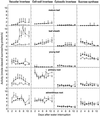
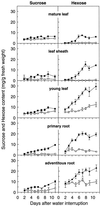
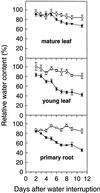
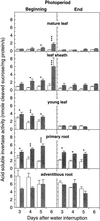

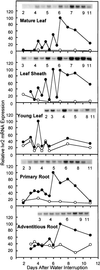
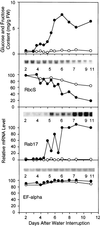

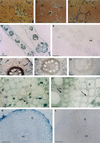
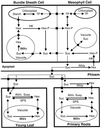
Similar articles
-
Soluble invertase expression is an early target of drought stress during the critical, abortion-sensitive phase of young ovary development in maize.Plant Physiol. 2002 Oct;130(2):591-604. doi: 10.1104/pp.005637. Plant Physiol. 2002. PMID: 12376627 Free PMC article.
-
Ivr2, a candidate gene for a QTL of vacuolar invertase activity in maize leaves. Gene-specific expression under water stress.Plant Mol Biol. 1999 Jan;39(2):373-80. doi: 10.1023/a:1006116310463. Plant Mol Biol. 1999. PMID: 10080702
-
The role of abscisic acid in the response of a specific vacuolar invertase to water stress in the adult maize leaf.J Exp Bot. 2003 Sep;54(390):2177-86. doi: 10.1093/jxb/erg234. J Exp Bot. 2003. PMID: 12925669
-
Extracellular invertase: key metabolic enzyme and PR protein.J Exp Bot. 2003 Jan;54(382):513-24. doi: 10.1093/jxb/erg050. J Exp Bot. 2003. PMID: 12508062 Review.
-
A role for 'futile cycles' involving invertase and sucrose synthase in sucrose metabolism of tomato fruit.J Exp Bot. 2001 May;52(358):881-9. doi: 10.1093/jexbot/52.358.881. J Exp Bot. 2001. PMID: 11432905 Review.
Cited by
-
Effect of osmo priming on sucrose metabolism in spring maize, during the period of grain filling, under limited irrigation conditions.Physiol Mol Biol Plants. 2019 Nov;25(6):1367-1376. doi: 10.1007/s12298-019-00706-z. Epub 2019 Sep 27. Physiol Mol Biol Plants. 2019. PMID: 31736540 Free PMC article.
-
Soluble invertase expression is an early target of drought stress during the critical, abortion-sensitive phase of young ovary development in maize.Plant Physiol. 2002 Oct;130(2):591-604. doi: 10.1104/pp.005637. Plant Physiol. 2002. PMID: 12376627 Free PMC article.
-
A Vacuolar Invertase CsVI2 Regulates Sucrose Metabolism and Increases Drought Tolerance in Cucumis sativus L.Int J Mol Sci. 2021 Dec 24;23(1):176. doi: 10.3390/ijms23010176. Int J Mol Sci. 2021. PMID: 35008600 Free PMC article.
-
Insights into Metabolic Reactions of Semi-Dwarf, Barley Brassinosteroid Mutants to Drought.Int J Mol Sci. 2020 Jul 19;21(14):5096. doi: 10.3390/ijms21145096. Int J Mol Sci. 2020. PMID: 32707671 Free PMC article.
-
Transcripts for genes encoding soluble acid invertase and sucrose synthase accumulate in root tip and cortical cells containing mycorrhizal arbuscules.Plant Mol Biol. 2002 Sep;50(2):197-211. doi: 10.1023/a:1016038010393. Plant Mol Biol. 2002. PMID: 12175013
References
-
- Broglie R, Corruzi G, Keith B, Chua N. Molecular biology of C4 photosynthesis in Zea mays: differential localization of proteins and mRNAs in two cell types. Plant Mol Biol. 1984;3:431–444. - PubMed
-
- Büssis D, Heineke D, Sonnewald U, Willmitzer L, Raschke K, Heldt HW. Solute accumulation and decreased photosynthesis in leaves of potato plants expressing yeast-derived invertase either in the apoplast, vacuole or cytosol. Planta. 1997;202:126–136. - PubMed
-
- Chen MH, Liu LF, Chen YR, Wu HK, Yu SM. Expression of a-amylases, carbohydrate metabolism, and autophagy in cultured rice cells is coordinately regulated by sugar nutrient. Plant J. 1994;6:625–636. - PubMed
Publication types
MeSH terms
Substances
LinkOut - more resources
Full Text Sources

